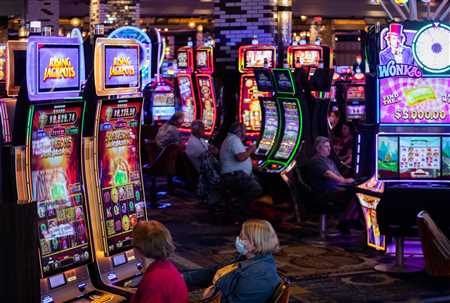

The intricate relationship between gaming establishments and large-scale entertainment venues has sparked significant discussions. As local governments strive to balance economic growth with community interests, regulations surrounding these establishments often lead to unforeseen challenges. Specifically, the nuances of seating capacities add another layer to this already complex landscape.
In recent times, the surge in popularity of grand entertainment spaces has prompted a critical examination of existing frameworks. Stakeholders, ranging from venue operators to lawmakers, find themselves navigating a maze of guidelines that may inhibit potential growth while aiming to preserve the cultural fabric of their communities. The push for expanding these venues prompts a closer look at the implications of various regulations and their impact on local economies.
As a result, stakeholders are tasked with re-evaluating their strategies and aligning their goals with the community’s desires. The evolving dynamics signify a need for collaboration among all parties to foster an environment where both entertainment and responsible practices can coexist harmoniously. In this intricate dance of interests, the path forward remains uncertain, highlighting the ongoing debate surrounding these expansive entertainment hubs.
The emergence of venues designed to accommodate performances and events in a specific capacity range has sparked intense debates among various stakeholders. These types of establishments, often situated alongside larger entertainment complexes, face scrutiny regarding their operational frameworks and the regulations that govern them. As interests collide, the implications for local communities, artists, and investors take center stage.
The discourse surrounding these venues involves a multitude of perspectives:
Local residents express concerns about noise and traffic disturbances.
Artists and performers advocate for spaces that can host diverse shows.
Investors focus on profitability and return on investment.
Finding common ground among conflicting parties requires innovative strategies:
Establishing clear guidelines to minimize disturbances for nearby residents.
Engaging local artists in the planning process to ensure their needs are met.
Creating revenue-sharing models that benefit both operators and the community.
Addressing the challenges posed by medium-sized entertainment venues is essential for fostering a harmonious environment that supports artistic expression while respecting community standards. Collaboration among all involved will be crucial in establishing a sustainable framework that accommodates diverse interests.
The establishment of large entertainment venues can have profound effects on surrounding neighborhoods and towns. These impacts can be measured in various dimensions including economic, social, and cultural aspects. While some residents might find opportunities for employment and increased revenue, others may face challenges related to noise, traffic, and shifts in the community’s character.
Economically, the introduction of sizable performance spaces often leads to a surge in local spending. Restaurants, hotels, and shops may benefit from increased patronage during events. However, the influx of visitors can also strain local infrastructure, leading to concerns among residents about the adequacy of public services such as transportation and safety.
Socially, these venues can serve as gathering spots, encouraging community interaction and engagement. They can host a variety of events that promote cultural enrichment. On the flip side, tensions may arise between long-time residents and newer visitors, particularly if the latter’s presence alters the fabric of the neighborhood.
Culturally, the introduction of a significant entertainment complex can enrich the artistic landscape, offering diverse programming that appeals to a wide audience. Yet, this dynamism could overshadow smaller, local entities, pushing them out due to increased competition and rising operational costs.
Ultimately, the advent of large-scale entertainment facilities necessitates a careful balance, ensuring that the benefits are maximized while mitigating potential downsides for the existing community. Stakeholder engagement and proactive planning are essential to navigate these complexities.
The existing regulatory framework surrounding entertainment venues and gambling establishments often reveals inconsistencies and ambiguities. These shortcomings in legislation can lead to varying interpretations that impact stakeholders across the industry. As new developments emerge, the lack of clarity in the statutes may create uncertainty among operators and regulators alike.
Ambiguities in venue classifications can affect licensing procedures.
Divergent opinions on the definition of allowable activities can hinder compliance efforts.
The evolving nature of entertainment offerings fuels confusion about regulatory applicability.
Conducting comprehensive reviews of existing regulations to identify and address gaps.
Engaging stakeholders in dialogue to clarify expectations and interpretations.
Implementing consistent training for regulators to ensure uniform enforcement of rules.
Addressing these interpretational challenges is crucial for establishing a stable environment that supports innovation while safeguarding necessary standards. A proactive approach toward legislative refinement may ultimately enhance the landscape for all involved parties.
The opinions of various stakeholders in the entertainment and hospitality sectors play a crucial role in navigating the landscape of large-scale venues. Each group approaches the situation from distinct viewpoints, which can lead to both opportunities and challenges. Understanding these perspectives is essential for achieving a balanced approach that satisfies the interests of all involved.
For venue owners and operators, the potential for increased revenue through ticket sales and event hosting is a primary concern. They see larger capacities as a means to attract big-name performers and generate higher foot traffic. However, they must also consider the regulatory environment and community sentiments that could impact their business operations.
On the other hand, local governments and regulatory bodies are focused on ensuring compliance with existing regulations while fostering a vibrant economic atmosphere. They weigh the benefits of tourism and job creation against the possible social implications and public concerns that may arise from hosting large gatherings.
Community organizations and residents often express varying levels of support or opposition regarding large venues. Some emphasize the importance of cultural enrichment and economic growth, while others raise concerns about noise, traffic congestion, and the character of the neighborhood. Listening to these voices is crucial for maintaining a positive relationship between businesses and the local population.
Ultimately, the interactions among these stakeholders shape the future of large entertainment spaces. Finding common ground through open dialogue and collaboration is essential for promoting sustainable growth and ensuring that all perspectives are considered.
The intricate web of regulations surrounding entertainment venues has given rise to a series of legal disagreements among stakeholders. As the industry evolves, differing interpretations of statutory provisions have resulted in tension between various entities seeking to establish their presence in this dynamic marketplace. These disputes reflect broader themes of economic opportunity, community interests, and governance.
Multiple parties are involved in these regulatory challenges, including venue operators, state authorities, and local governments. Each group brings unique perspectives and priorities. While one faction may advocate for increased capacity and entertainment options, another may emphasize concerns regarding community impacts and regulatory compliance. The balancing act between economic development and social responsibility remains a focal point in these discussions.
Unsettled regulations can lead to significant repercussions for all involved. Potential investors may hesitate to commit resources amid an unpredictable legal environment, leading to lost opportunities for job creation and revenue generation. Additionally, ongoing disputes can erode public trust and complicate the licensing process, ultimately hindering the growth of the industry as a whole.
In summary, the regulatory landscape surrounding entertainment venues is marked by complexities and contrasting interests. As stakeholders navigate these challenges, the outcomes will shape the future of the industry’s development and its integration within the broader social fabric.
This section delves into various instances where significant entertainment establishments have sparked debate and disagreement within communities. These developments often raise questions regarding economic impact, social implications, and local culture, leading to various reactions among residents, stakeholders, and policymakers.
This initiative aimed to transform a downtown area into a multifaceted entertainment complex. The proposal included a large venue for performances and events, but it faced backlash from locals concerned about noise and traffic congestion.
Community Concerns: Residents expressed fears of increased crime rates and diminished quality of life.
Economic Promises: Proponents highlighted potential job creation and tax revenue benefits.
Regulatory Challenges: The proposal underwent numerous revisions and public hearings before receiving approval.
This development aimed to introduce a resort-like atmosphere along a popular shoreline. While supporters anticipated tourism boosts, opponents worried about environmental degradation and over-commercialization of the area.
Support for Local Businesses: Advocates argued that increased visitors would help sustain nearby shops and services.
Environmental Impact Assessments: Critics called for thorough reviews to safeguard natural habitats.
Public Opinion Shifts: As discussions evolved, some community members began to see potential benefits, while others remained staunch opponents.
These case studies illustrate the complexities involved in planning entertainment hubs, emphasizing the need for comprehensive discussions that consider all viewpoints and long-term ramifications.
The interaction between regional and municipal governance can often lead to tensions regarding the management and regulation of entertainment venues. This relationship encompasses various elements, including jurisdictional authority, policy implementation, and revenue distribution. Understanding these dynamics is crucial for identifying potential areas of friction and collaboration.
At the core of this issue lies the balance of power. While state officials may establish overarching guidelines and regulations, local jurisdictions are responsible for addressing community needs and preferences. This can sometimes lead to discrepancies in how policies are enacted, prompting disagreements over specific operational rules and standards for large-scale performance spaces.
As both entities strive to fulfill their distinct responsibilities, navigating this landscape becomes imperative for ensuring that the interests of all stakeholders are considered. Collaborative efforts and clear communication channels can help mitigate misunderstandings and foster a more cohesive approach to managing performance venues in communities.
This section delves into the intricate legal disputes and judicial decisions surrounding large entertainment venues. As various entities vie for operational licenses and regulatory compliance, the court’s interpretations play a crucial role in shaping the landscape of entertainment and wagering in the region.
Numerous stakeholders have initiated lawsuits contesting the validity of permits issued for large venues.
Key legal arguments focus on zoning regulations and the eligibility criteria for establishing such venues.
Opponents claim that granting licenses undermines community standards and violates local statutes.
Recent rulings have underscored the necessity for comprehensive environmental assessments before any expansions.
Courts have emphasized the need for transparency in the licensing process to ensure fair competition.
Several decisions have reiterated the importance of adhering to pre-existing municipal regulations governing entertainment facilities.
The evolving legal landscape continues to influence future projects and may lead to revisions in regulatory frameworks to address ongoing concerns.
The integration of performance venues within gaming establishments introduces a myriad of hurdles for regulators and operators alike. The regulatory framework must balance the interests of various stakeholders while ensuring compliance with established guidelines. This complexity often leads to competing priorities that can hinder the development of theater spaces.
One significant obstacle is the allocation of resources and space, as larger venues may require more extensive infrastructure to accommodate audiences, which can clash with the existing operational footprint of gaming facilities. Additionally, the need for specialized permits can complicate the approval process, leading to delays and increased costs for developers.
Moreover, community concerns regarding noise, traffic, and overall impact on local culture can intensify scrutiny of proposed projects. Engaging with residents and addressing their apprehensions often becomes a crucial part of the licensing discussions, further complicating the proceedings.
Lastly, the dynamic nature of the entertainment industry requires flexibility in regulations to adapt to evolving trends and audience preferences. This necessity can lead to ongoing negotiations between entities seeking to establish performance spaces and the authorities tasked with overseeing compliance, ultimately shaping the landscape of such venues within the broader entertainment sector.